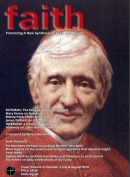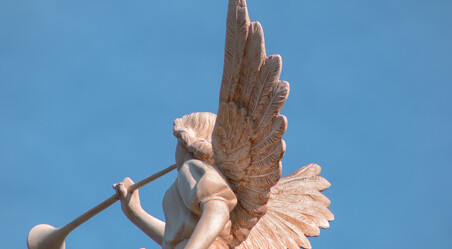The Analogy of Faith And The Sanctification Of Man
Jeffrey Kirby FAITH Magazine January-February 2005
Introduction
The world today supports people who seek truth and who explore for answers to their questions; however, it shames those who claim to have found the truth and silences those who want to share the truth they have discovered with others. Further, the world permits lies to be presented as truth and half-truths to be argued as fullness. Truly, we live in an age of self-imposed untouchable truth, of lies and half-truths, of answerable questions left unanswered, and of supposed tolerant people who are viciously intolerant to assertions of truth. Where are we to go from here? Is there a direction beyond the counsel of this world and its fallenness?
Yes. God, who exists as a Trinity of Persons, has given the world another direction. Through the deliverance by the Father of the Son, within the distinct yet inseparable ministry of the Holy Spirit, God himself welcomes man to share in his own life and love. God the Son became a man and declared himself the Truth (John 14:6). He invites all people to come to him for the answers to their questions and rest from their labors.
Man, in his act of faith in the Son of God, accepts the invitation and enters into God Himself and, in this mutual yielding between God and man in the Christic Mediator, man comes not only to a deeper understanding of God but simultaneously, as if in a single movement, to an ever-spiraling depth of awareness of his own personhood. This occurs principally in his acceptance and surrender to truth, which becomes expressed in the analogy of faith. The analogy of faith is the reality which demonstrates the inter-connectedness and singular expression of all truths in the divine simplicity of God’s One Utterance, Jesus Christ, who is the Word made flesh and the fullness of revelation.
When man surrenders in faith to this Word, he begins the slow process, often marked by tension and pain, of purgation, illumination and deification. The Word, which is alive and active cutting to the marrow (Heb 4:12), gradually transforms the person, allowing him to become more fully himself in Christ. Concurrently, the person grows in wisdom, which is the ever-expanding, widely promiscuous grasp and retreating resignation to the truths of faith, as well as their application in the many aspects – familial, political, moral, social – of his life. These reciprocal actions of the Word and of man rely on one another and neither of them can occur without the other. Man’s act of faith, initiated by grace, begins and permits this development and remains the hinge upon which it all rests.
The Activity of the Triune God
As Being itself, God is not static but there exists a constant activity of transmission between the Father, Son and Holy Spirit. The Persons of the Trinity are distinct Persons; however, as divine Persons their distinctness is one, not of essence, but of relation. God the Father, therefore, is not merely spoken of as a symbol of fatherhood or as being “like a father,” but as being Father. So with the Son as Son, and with the Spirit as Love. The relation is of the divine essence and inseparable from it. To divide the essence from the relation is to make the relation a creature and to cause confusion in the understanding of the divinity. As a Family, the Godhead’s relationality is central to himself and to the dynamism and veil of mystery that surrounds him.
The dynamism between the Persons should not be seen as an “effect proceeding from a cause” (this could lead to modalism which denies divinity to the Son) or even as the “cause going to the effect,” as moving it or making its own image upon it, in which case the “persons” of God would only be a mask of a truly singular Person. Both of these errors understand the activity of procession as an outward act and so deny such a movement within God.
These views fail to recognize a possible inward action by an agent, such as an act of the intellectual power within man: he proceeds in knowledge to understand an object. God must be understood not according to the mode of the lowest creatures, material bodies, but from the mode of the highest creatures, the intellectual substances. Although even this illustration falls drastically short in representing the activity of divine objects; nevertheless, with this understanding, procession should not be understood from what is in our bodies but rather from what is the movement of an intelligible emanation.
God, because he is love in his inner life, processes love within himself. The activity between the Persons is one that is Love and that shares Life. The Father begets the Son and the Love between the two is the Holy Spirit. This co-activity, this inter-subjectivity, is the mark of the movement within God, and the exemplar to all creation of its own nature and final destiny.
The Son’s Deliverance as Invitation
As finite and contingent being, the human person exists within the abyss of existence as a pilgrim on a journey. In his expedition of life, with a hunger for meaning and desire for fulfillment, he has many questions: What is man? What is the meaning of suffering, evil and death, which persist even in the midst of such progress? What can people contribute to society and expect from society? What comes after this earthly life? These questions, without assistance, can lead man to alienation and despair.
God, Creator and Lord of creation, not wishing man to be left in confusion and disorder, freely chose to initiate a personal revelation of Himself to man. Man, therefore, stands as a privileged partner and graced act-or in this self-disclosure of the Divinity. Precisely because God is the almighty and eternal, immeasurable, incomprehensible, infinite in will, understanding and every perfection, he chose to approach man progressively in “many and various ways” (Hebrew 1:1).
This revelation of God to man can be divided into the natural and supernatural. In the natural order, God shows himself to man in creation and within man’s own conscience and spiritual yearnings. Man, with the light of reason, has the capacity through these discreet disclosures by God of Himself, to know of God’s existence and the elementary truths about Him. The supernatural revelation of God is the blatant invitation for man to enter into His intimacy: to know Him, love Him, and to be a trusting friend. Respecting man’s fallen nature, which is prone to error and sin, God enters and positively yet gradually shares His knowledge of Himself to man through history and then “in, with and under” other experiences. Through these mediums, such as miracles, personal inspirations, and propheticmessages, God presents man with the encouragement of entering into a filial covenant with Him.
The summit of this radically ineffable sharing by God to man came in the Person of Jesus Christ. Within the Godhead, the Father asked who could be sent to redeem man and the Son, in loving obedience, answered, “Here I am. Send me” (Isaiah 6:8). From the transmission within the Trinity, therefore, the Son, by the power of the Holy Spirit, was delivered to man. God entered human history as a friend and as the answer to man’s questions. As the Incarnate Logos, He is and will be the end and ever-new, Alpha and Omega, of God showing and giving Himself to man. By his life, death and resurrection, Christ has definitively revealed God to man and man to himself, in order to conclusively invite and receive humanity into relationship with Himself.
God, the ultimate witness to Himself, resting on His own authority displayed in prophecy, miracles and internal illuminations, extends His hand fully in Jesus Christ and offers man communion. Against the dark backdrop of a world that asserts non-belief and imposes upon man an atheistic model of reality, the human person is presented with the vulnerable and pierced hand of love from the Word Incarnate.
Man’s Act of Faith
Restless to find answers to his questions and the foundation of his life, man is called to accept the divine hand, marked by the brutality of the Cross, which is offered to him. Called into this intimacy with God, man’s only adequate response is one of adoration. He begins this existential adoration through an act of faith.
Faith can be defined as a gift from God, a supernatural virtue, which calls for a submission of the intellect and will and which, through the grace of God, allows the person to believe, as true, what God has revealed. It can further be defined as a total and free self-commitment to God, through the working of the Holy Spirit, which willingly assents to the revelation which He gives to man.
To understand the full depth of the act of faith, three distinctions can be made: credere Deum, credere Deo, and the credere in Deum. The act of faith which merely “believes God exists,” the credere Deum, is a “faith” that is not necessarily supernatural but is rather limited only to an acknowledgement of a Being’s existence. Although it can be a first step or initial action of the person towards God, this act of faith, which even the fallen angels cannot deny, does not contain the fullness of the response which God invites man to make.
The act of faith that “believes God,” credere Deo, and acknowledges the propositions of faith as true and trusts that God’s words are without error; even this, although praiseworthy and necessary for salvation, does not contain the fullness of faith that God offers to man. These two acts of faith are insufficient in themselves and are lacking in depth and vitality because they can exist without love.
The act of faith that “believes within God,” credere in Deum, is when the person, conscious of his own weakness, turns to God and seeks to know about God from God Himself. It is when man goes beyond the formal object of propositions and encounters the Reality and believes from that simple intuition. This is the faith that God desires for man, has made possible for him at a tremendous price, and encourages him, by external and internal proofs and illuminations, to enter and integrate within his own being and life in order to become a new creation. To make this act of faith, this simple yet profound movement of adoration, the human person must respond to grace and work to love God. Only those who truly love God are able to believe in Him.
The person receives faith only to the extent that he accepts it and is open to it. Faith is the “primordial choice” that man makes as to what degree he will open himself to the divine mystery and, in it, understand and approach life, the world, man and history. When fully lived, faith becomes not only a fact but an occurrence. It embraces the entire person and each of his acts is marked by an understanding of God’s activity, not only always and everywhere but particularly here and now.
The Steps Towards Faith Begun by Wonder
Pursuing the appropriate act of faith, man is ordinarily motivated by his existential questions. While the human person, with the use of his reason, possesses and poses his questions, he is also the recipient of wonder, an experience of awe when in the presence of finite beauty, truth or goodness, which propels him to the Infinite fulfillment of these transcendental experiences. It is God seeking the person in, with and through different occasions, people and objects that inducts the person into this awareness. It is this awareness that allows him to formulate his curiosity and clearly express his questions. Synthesizing the questions and seeking the answers is a serious, lifelong commitment to struggle through the tension of this questioning-and-answering, which, if cooperated with,eventually becomes a part of the person’s very definition by leading him to the full act of faith called for by God.
This engagement by man can be seen as a process that consists of three concentric and complementary circles. The first and most universal of these circles is the experiencing by the person of existence itself. God as Creator can use anything to instill this wonder and call man to Himself. It would be disastrous to attempt to limit God only to the supernatural or merely to the miraculous. The work of God is as large as creation itself and uses this creation as a sacramental, by which man can recognize, know and praise God. Nature, other persons, poetry, art and music, plays and film, are all avenues of this first circle of wonder calling man to faith in the living God.
This first circle is not enough, however, and needs a second circle to balance it. The second circle would be the special history that has defined the unveiling of God. By desiring to understand history and placing himself, as far as is humanly possible, in the position of those who have gone before him, the person wants to know their viewpoints, hopes and fears. This action by the person is a reaching out to the long-dead generations and a re-creating of their thoughts and words, allowing them to instruct and enlighten him about God. This is a difficult task but must be made because, as a God of history, the Trinity calls man, especially in the historical Person of Jesus Christ, to know Him and to comprehend His movements and self-revelation through the ages.
The third and smallest circle in this process of wonder is tradition. It is the circle that the others lead man to and that enlivens the other circles with meaning and value. Tradition serves as an object and the medium of the person in his quest for answers within God.
Tradition is an offering by which the Father’s gift if communicated to a humanity throughout the world and in successive generations so that, even if separated by time and space, they are nevertheless incorporated into the same, unique, identical reality, the revelation of God especially in his Son, Jesus Christ. It is not only a book or a codex or an anthropology but, by the power of the Holy Spirit, tradition is an environment and atmosphere in which the person sees, smells, hears, tastes and touches the lived faith of a believing community. This holistic encounter forms man and guides him towards the appropriate act of faith. It allows him to see and adopt himself to what his fathers held and what has been held from generation to generation, since the time of the apostles. It calls himto become a beneficiary of the apostles’ heritage through faith. If he accepts, the person approaches the belief in God, which, while profoundly personal, is never individualistic. Man’s faith always relies on and is grounded upon the faith of the whole Church, which is the fellowship of the faithful of Jesus Christ.
Into God in Christ
Compelled by wonder in desiring answers to his questions, as well as meaning and purpose in his life, man is led through creation, history and tradition to reach the full act of faith, the existence of lived adoration. Jesus Christ, the pre-eminent bearer of revelation, as the Incarnate Logos, is the mediator and benefactor of man, giving human Utterance to the Word of God. Man is summoned into the cloud of unknowing in, with and through the corpus of this Utterance. The truth of God is found primarily in His very being. Christ is not simply one among many material objects of faith, credere Deo, but, in his humanity, is the locus in which the Formal Object – God Himself – is encountered. The whole of revelation converges in Christ and has its definitive truth only in Him.
The man who accepts the life of faith, credere in Deum, re-acts to the action of God in revealing himself, it is his “yes” and “amen” to God, with all that may or may not come with that action. In undertaking this voyage of faith into God, the person begins a dynamically divine drama of life and love between himself and the Godhead. The person grows in an inward awareness of who God is and becomes gradually more conscious of the nuptial unity between himself and God. He begins to perceive God’s being and discern His mind. The person becomes more alert to his own self and to God’s image within him.
As he freely surrenders more to God and enters into Him, the person becomes more fully himself in Christ by allowing grace to heal his wounds from sin and evil and to actualize his potential in virtue, talents and even personality. The person truly becomes consciously transformed into a new creation. Standing as himself, the person is shown his dignity. He realizes that he holds a privileged place in the cosmos as a child of God by adoption, and therefore is the summit, focal point and crown of God’s creation. He sees how he is a reflection and, in a sense, is the glory of God.
An apparent juxtaposition – man entering God and believing in Him and also becoming more fully himself as a person – becomes a paradox that is reconciled in the hypostatic union within the Person of the God-man. In this seemingly single, yet distinct, act by the person, he begins to participate in the very activity of God and to share, through Christ his Mediator, in the divine nature (2 Peter 1:4). The person begins to see not only how God has entered him, especially in the impression of His image, but also how he can perpetually enter into God, seeking greater Wisdom and Love and being transformed from glory unto glory.
The Eyes of Faith
As a person becomes more conscious of God, himself and the relationship between them, he is called to cast off the spirit of the world and to renounce sin. To the extent that he does this, he will be able to spiritually see, hear, taste and touch God (1 John 1:1-2). In this growth into God, man begins to see the unity of God extended and reflected in the analogy of faith. The analogy of faith is the coherence of truths among themselves and within the whole plan of revelation. The analogy of faith, difficult to see by those with carnal eyes and heart, can steadily be given to the mind and heart of the person of faith. The person, in entering God. starts to see, beyond the contingent differences and distinctions in this world, the connection between God and His teachings. The common divide,the “scales” of finite being, which is a part of time and space, sadly edified by sin and the social errors of the day that deny and kill the spirit, such as hedonism and materialism, is gradually diminished by grace in the person possessing the fullness of faith.
The analogy of faith depends upon the credere in Deum in which the person has come through the propositions of faith and is now experiencing the realities of faith themselves. The person no longer sees merely a collection of truths or an organized system of immutable statements in a creed. The Creed ceases to be only a stop-sign, a requirement of belief, and becomes instead a boundlessly fruitful unity, endlessly unfolding to the eyes of faith. The person now sees – in God’s own divine simplicity – the oneness of these truths in the One incarnate Logos.
The truths of life no longer contain the appearances of incongruity or the façade of discrepancy. They are clarified and ordered in the mind and heart of the believing person. Previous occasions of confusion are corrected, seemingly contradictions are shown to co-exist in a beautiful Reality, agonies and former anguish are rewarded in seeing the connections and even dependency of truths on other truths. The former sense of confinement is now replaced by an indefinite sense of freedom. The harmony and homogenous nature of the truths sing out, as they are, to the soul now open and panting for Wisdom and Love. The person ceases to “grasp the faith” and rather begins to be grasped by it.
As the scales drop and man sees the activity of the truths of life in service to the Truth, he understands and is enlightened to an even greater and inexhaustible awareness of his own humanity, of God, their relationship and the great circle of being flowing from and returning to God. In this enlightenment, this immeasurable precision of clarity, man, according to his free will, becomes liberated from private fantasies, the peer pressure of popular trends, the pull of the world, and the enticement to sin. In seeing the analogy of faith, the radical indivisibility of truth, the person is called to more profoundly assimilate and integrate himself and his life into this Reality, which is God.
Tension and Pain
While the illumination of the mind and heart and the conformity of the person’s life and desire for transformation are distinct acts; nevertheless, in the act of faith, they must simultaneously occur or else neither will occur at all. If the person begins to see the analogy of faith, it is because he has allowed God to show it to him. If the person ceases to grow in love, the life of wisdom will dry up and bear no fruit. This is the difficult task of the person who wants to believe: credere in Deum. It is an arduous task; however, to the one who makes it, God himself will walk with him and desire to make the yoke easy and the burden light.
The person must allow his faults, weaknesses, and sins to be the very path that God uses to transform him. If man steps onto the wrong path, which seeks to convince him that he must work to remove and leave these undesirable elements behind, he does not let God work and seeks to redeem himself (like Pelagius). If he steps onto another misleading path, which convinces him that these are not important or superfluous to the “real” him, and he ignores them and tries to believe in God, he will not be given passage because he does not want redemption at all, except maybe from the hazards of this world (like Confucius or the Buddha).
No, for the human person to enter the right path he must take up his cross and truly follow Christ (Matt. 10:38). He must see his weaknesses, faults and even his sins as the very crosses that will be the source of his own salvation. Not separate entities or unimportant issues, these elements allow the person to recognize his own creature-ness and finitude, and calls him to seek salvation, not from himself or from this world, but from sin and evil. To begin to face the sorrow of his own fallenness, recognize his own dismerit, acknowledge his own unworthiness and smallness, submit to his existential awkwardness and essential discomfort, the person permits God to work. It is precisely in his areas of sinfulness, embarrassment, shame, confusion, loneliness and even despair, that Christ willask him to stretch out his hand.
In desiring Him alone and following His commands, not worrying about the thoughts of this world or the respect of man, the person will stretch out his hand and allow Christ, exactly in these sensitive areas, to begin the work of redemption.
The Reliance on the Will:
This strenuous act of faith entered into by man with questions and awe, is the hinge upon which this entire drama depends. At its source, it is a movement of love because it is love that inspires every action towards goodness. It moves the will to follow God and makes faith possible and allows it to deepen.
It is only love, therefore, that directs the person to trust and accept communion with a witness and, in the act of faith, the Witness is God Himself. The Witness says “it is so” and the person, using his will, makes the statement his own and is able to see something which he would never have been able to see through his own abilities and talents. It is this turning of the will that makes the act of faith and allows the person to endure the struggles and trials of living by faith.
Seeing the extended hand of God, the will awakens the intellect to accept the offer. This will and the intellect, inflamed by love, make this affirmation and assist the person in persevering in his act of faith. God’s grace initiates, supports, and pervades this entire internal process within the person. Having once made the act of faith, the person chooses to what degree he will let God work. If he adheres to God’s will and walks the correct path, the person can attain and persevere credere in Deum, and the heights of “likeness” unto God Himself.
Conclusion
Through the act of the will, moved by love, the human person is able to make and sustain an act of faith. This act of faith answers his questions and explains his awe. It places him within a complex struggle with various forces within himself and the world around him. If he stays on course and seeks the face of God, his act of faith will deepen and God will be able to work more profoundly. As the person grows in his faith, a deeper sense of God and of his own personhood is given. This unveiling displays to the person the simplicity of God himself. In his growing awareness, man sees ever more deeply God’s image in his own person, as well as his own capacity to enter into God. If he desires to enter God, he meets his mediator and guide. Christ, God-Man, who initiated the call and assistsits completion, encounters the person and allows him to enter the life of the Trinity Himself.
In entering the life of the Trinity by assimilation into Christ, the person becomes capable of seeing the analogy of faith. The analogy shows man the inter-connectedness and unity of truths and allows him to see the harmony of creation and the glory of God’s created cosmos. It shows him the great circle of being that begins with God and rests with Him.
The person who perseveres in love and belief in God, comes to the existential adoration of the Godhead, which celebrates His glory and exalts in His splendor. Such a person, standing on the horizon of existence, is truly free in Christ and lives while singing, “My soul proclaims the greatness of the Lord and my being rejoices in God my savior” (Lk 1:46-47).





